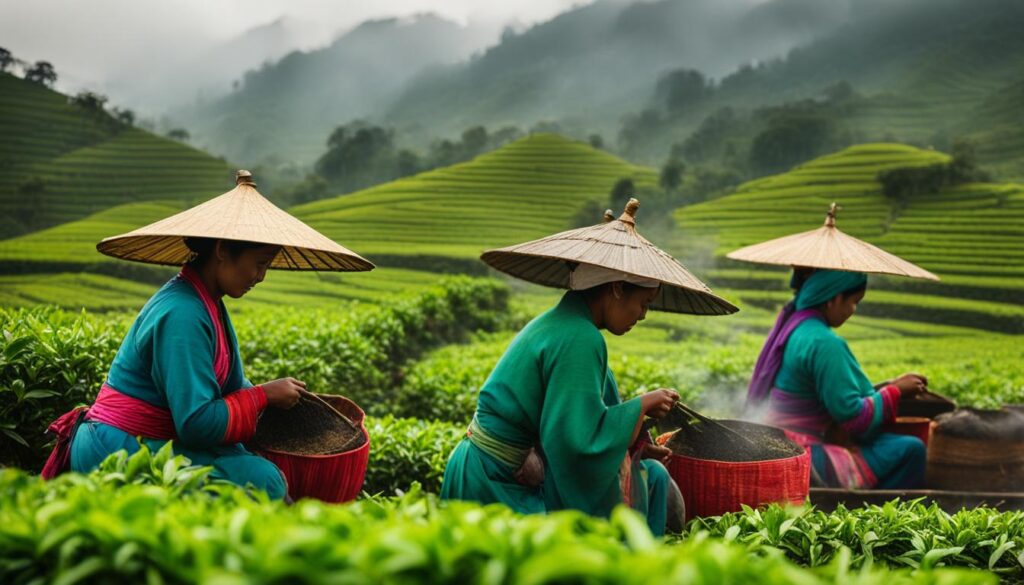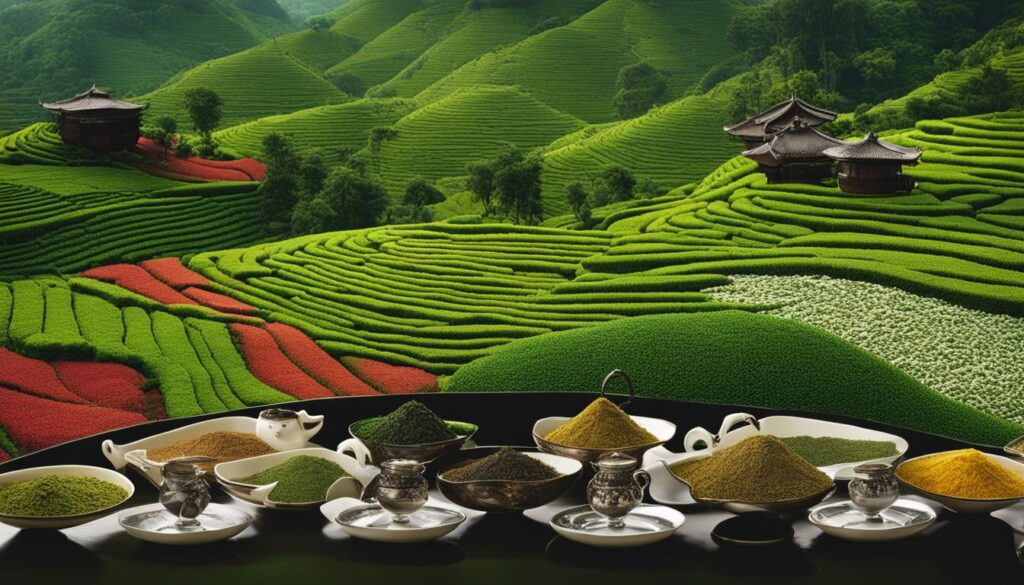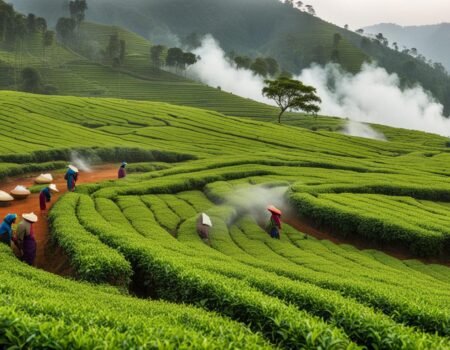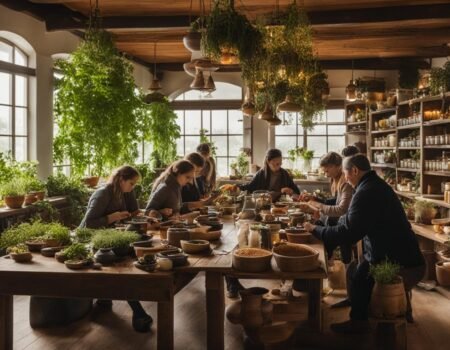
Diverse Cultivation of White, Green, Black, and Oolong Teas
Welcome to our guide on the diverse cultivation of white, green, black, and oolong teas. As tea enthusiasts, we’re excited to explore the different flavors, aromas, and cultivation practices that make each type of tea unique. From the delicate and subtle flavor of white tea to the strong and bold taste of black tea, there’s a whole world of tea waiting to be discovered!
Key Takeaways:
- White, green, black, and oolong teas all come from the leaves of the Camellia sinensis plant.
- The level of oxidation during processing determines the flavor and aroma of each tea type.
- White teas are the least processed and have the least amount of caffeine.
- Green teas are not oxidized, resulting in a fresh and astringent taste.
- Oolong teas are semi-oxidized, offering a balance between black and green teas.
The Art of Cultivating White Teas
White teas are a delicate and nuanced type of tea that requires careful cultivation and harvesting techniques. The process of cultivating white teas begins with selecting young tea buds that are tightly enclosed in new leaves. These tender buds are plucked by hand, ensuring that only the most delicate parts of the tea plant are used.
One of the key aspects of white tea cultivation is the minimal processing involved. Unlike other types of tea that undergo extensive rolling or crushing, white teas are simply withered and dried. This gentle processing method helps preserve the delicate flavor and aroma of the tea.
Traditionally popular in China, white teas are now gaining recognition in America for their subtle and nuanced taste. They are best enjoyed when brewed with pure water heated to 175°F, allowing the delicate flavors to fully emerge.
White Tea Harvesting Techniques
White teas are known for their unique harvesting techniques that require precision and patience. To ensure the highest quality, white teas are harvested early in the spring when the tea buds are at their peak. These buds are meticulously handpicked, selecting only the youngest and most tender leaves.
The careful harvesting process ensures that the tea leaves are not bruised or damaged, preserving their delicate flavors. This meticulous attention to detail contributes to the exquisite taste and aroma of white teas.
| Harvesting Technique | Description |
|---|---|
| Bud Picking | Only the unopened buds are selected for harvesting. |
| Tender Leaf Selection | Young, tender leaves are chosen to ensure the best quality. |
| Handpicking | The leaves are carefully plucked by hand to avoid damage. |
“The art of cultivating white teas lies in the delicate balance of harvesting the young tea buds and preserving their natural flavors. It is a labor of love that results in a tea like no other.”
The unique cultivation and harvesting techniques make white teas a true work of art. From the careful selection of tea buds to the gentle processing methods, every step is designed to bring out the delicate flavors and aromas of this exquisite tea. Whether enjoyed hot or cold, white teas offer a refreshing and subtle taste that is sure to delight tea connoisseurs.
Green Tea Harvesting and Processing
Green tea cultivation and processing play a crucial role in creating the unique flavor and aroma of this popular tea variety. Green teas are known for their fresh and astringent taste, which is achieved through minimal oxidation during processing. Let’s explore the steps involved in green tea production:
- Harvesting: Green tea leaves are typically plucked in the morning when they are young and tender. This ensures the highest quality and optimal flavor.
- Withering: After harvesting, the leaves are spread out in a well-ventilated area to remove excess moisture. This step helps to prepare the leaves for the next stage of processing.
- Heat Treatment: The leaves are then quickly heated to stop any oxidation and preserve their green color. In Chinese green tea production, the leaves are often pan-fired in a hot wok, while Japanese green teas are steamed.
- Rolling: The leaves may be gently rolled or shaped to enhance their flavor and aroma. This step helps to break down the cell walls and release the natural oils, resulting in a more flavorful cup of tea.
- Drying: Finally, the leaves are dried to remove any remaining moisture and further preserve their quality. The dried leaves are then sorted and packaged for distribution.
It’s important to note that the specific processing methods can vary depending on the type of green tea and the region where it is produced. Chinese green teas, such as Lung Ching and Gunpowder, have their unique traditions, while Japan is famous for its Gyokuro and Matcha teas. Regardless of the techniques used, brewing green tea requires pure water heated to approximately 175°F to bring out the best flavors and aromas.
Green tea is a treasure trove of health benefits. It is rich in antioxidants, which help fight free radicals and protect the body against oxidative stress. Regular consumption of green tea has been linked to a reduced risk of heart disease, improved brain function, and weight loss. So, next time you sip on a cup of green tea, savor the flavors while knowing that you’re doing something great for your health!

Types of Green Tea
Green teas come in various forms, each with its own distinct characteristics. Here are a few popular types of green tea:
| Green Tea Type | Origin | Flavor Profile |
|---|---|---|
| Sencha | Japan | Fresh, grassy, vegetal |
| Dragon Well (Long Jing) | China | Roasted chestnut, sweet |
| Gunpowder | China | Strong, smoky |
| Mao Feng | China | Light, floral |
These are just a few examples of the wide range of green teas available. Each type offers a unique flavor and aroma profile, allowing tea enthusiasts to explore and discover their personal preferences.
Discovering the World of Oolong Tea
When it comes to tea, oolong stands out as a unique and intriguing option. Known for its semi-oxidized nature, oolong tea offers a delightful balance between the freshness of green tea and the complexity of black tea. With a range of flavors and aromas, oolong tea cultivation showcases the craftsmanship and artistry of tea producers around the world.
One of the key characteristics of oolong tea is its varying levels of oxidation. Depending on the desired flavor profile, oolong teas can range from 8% to 80% oxidation. This range allows for a diverse selection of flavors, from light and floral to rich and toasty. The level of oxidation is achieved through a unique withering and rolling process that brings out the distinct qualities of oolong tea.
Taiwan is particularly renowned for its exceptional oolong teas. The island’s tea growers have perfected the cultivation and processing techniques, resulting in teas that are highly sought after by tea connoisseurs. One such famous oolong tea is Ti Quan Yin, a charcoal-fired variety known for its deep, roasted flavor. Ti Quan Yin embodies the essence of oolong tea, showcasing the intricate flavors and aromas that make it so distinctive.
The World of Oolong Tea Varieties
Oolong tea comes in a variety of forms, each with its own unique characteristics. Here are some popular oolong tea varieties:
- Rou Gui: A famous Chinese oolong tea with a cinnamon-like aroma and a rich, fruity flavor.
- Da Hong Pao: Also known as “Big Red Robe,” this tea is highly prized for its complex flavors and long-lasting aftertaste.
- Tie Guan Yin: A classic oolong tea with a floral aroma and a delicate, sweet taste.
- Dong Ding: Grown in Taiwan, Dong Ding oolong tea is known for its smooth, creamy texture and notes of honey.
These are just a few examples of the wide variety of oolong teas available. Each tea offers a unique taste experience, making oolong tea a true delight for tea enthusiasts.
| Oxidation Level | Flavor Profile |
|---|---|
| Light (8-20%) | Delicate, floral, and fresh |
| Medium (25-50%) | Fruity, nutty, and creamy |
| Dark (60-80%) | Rich, roasted, and toasty |
“Oolong tea is a true testament to the art of tea cultivation. From the delicate flavors of lightly oxidized teas to the bold richness of dark oolongs, there is a world of variety waiting to be explored.”
Exploring the World of Black Tea
Black tea, known for its strong and bold flavor, is a popular choice among tea enthusiasts around the world. The cultivation and processing of black tea differ from other types of teas, resulting in its distinctive characteristics. Let’s delve into the fascinating world of black tea cultivation, processing, and the oxidation process that gives it its unique qualities.
Oxidation Process for Black Tea
The key step in black tea processing is oxidation, where the tea leaves are exposed to air and undergo enzymatic reactions. This process is also known as fermentation, although it doesn’t involve the same microbial fermentation as in wine or beer production. The oxidation of black tea is a controlled process that transforms the chemical compounds in the leaves, resulting in the dark color and robust flavor.
The level of oxidation plays a crucial role in determining the characteristics of black tea. Fully oxidized black teas have a deep red or amber liquor, while lightly oxidized teas can have a brighter, golden color. The oxidation process can vary from a few hours to several days, depending on the desired flavor profile and tea variety.
Black Tea Cultivation and Processing
Black tea is primarily cultivated in regions such as China, India, Sri Lanka, and Kenya. Different countries have their own unique cultivation and processing techniques that contribute to the distinct flavors and aromas of their black teas.
During cultivation, black tea bushes are regularly pruned and maintained to encourage the growth of new shoots and leaves. The leaves are picked at specific times to ensure optimum flavor and quality. After plucking, the leaves are withered to remove excess moisture and then rolled to release the natural enzymes responsible for oxidation. The rolled leaves are then spread out to oxidize, and the oxidation process is halted through heating or drying. Finally, the leaves are sorted, graded, and packed for distribution.
| Country | Notable Black Teas |
|---|---|
| China |
|
| India |
|
| Sri Lanka (Ceylon) |
|
| Kenya |
|
Each country’s black teas have their own unique flavor profiles, ranging from malty and robust to floral and fruity. Exploring the world of black tea introduces us to a rich tapestry of flavors that can be enjoyed in various preparations, from a classic cup of hot tea to iced tea blends and specialty tea beverages.
“Black tea is like a comforting embrace, providing warmth and a burst of flavor. Its boldness is a testament to the diversity and craftsmanship that goes into its cultivation and processing.”
White, Green, Black, and Oolong Tea – Same Plant, Different Processing
All four types of tea – white, green, black, and oolong – come from the same Camellia sinensis plant. What sets them apart is the level of oxidation they undergo during processing. This oxidation process plays a significant role in determining the flavor and aroma of each tea variety.
White tea, being the least processed, retains a delicate and subtle flavor. Green tea, on the other hand, undergoes minimal oxidation, resulting in a fresh and astringent taste. Oolong tea strikes a balance between black and green teas, offering a wide range of flavors due to its semi-oxidized nature. Black tea, fully oxidized, brings forth a bold and strong brew.
The differences in the oxidation process contribute to the unique characteristics of each tea type. While white tea is known for its light and floral notes, green tea offers a refreshing and vegetal taste. Oolong tea presents a complexity of flavors ranging from fruity to toasty, while black tea delivers a robust and rich profile. These variations in flavor and aroma make tea drinking an exciting and diverse experience.
Regional Variations in Tea Processing
Traditional Tea Processing Methods
The world of tea is vast and diverse, with each region and country having its own unique tea processing methods. These traditional techniques have been passed down through generations, resulting in teas with distinct flavors and aromas. From the delicate and subtle white teas of China to the strong and robust black teas of India, the art of tea processing is a reflection of cultural heritage and expertise.
Tea Processing Techniques by Country
China, known as the birthplace of tea, has a rich history of tea cultivation and processing. Chinese green teas, such as Lung Ching and Gunpowder, are heated immediately after plucking to prevent oxidation. This results in fresh and astringent teas with grassy and vegetal flavors. Japan, on the other hand, steams their green teas, creating teas with a unique umami flavor and vibrant green color.
Taiwan is renowned for its oolong teas, which undergo a meticulous process of withering and rolling before being partially oxidized. This technique produces teas with complex flavors ranging from floral and fruity to toasty and nutty. India, famous for its black teas, employs a method of fully oxidizing the leaves to create bold and malty teas with a strong caffeine kick.
Regional Tea Processing Methods
Each region within a country also has its own tea processing methods, leading to further variations in flavor and aroma. For example, in China, Northern and Southern regions produce different styles of black tea. Northern black teas, such as Keemun, are known for their sweet and fruity flavors, while Southern black teas, like Dian Hong, are bolder and more robust.
In India, the Darjeeling region produces teas with a distinctive muscatel flavor, while Assam teas have a strong and malty taste. Nilgiri teas from the southern region of India are known for their bright and brisk character. The terroir, climate, and soil conditions of each region contribute to the unique qualities of their teas.
| Country/Region | Tea Type | Processing Method | Flavor Profile |
|---|---|---|---|
| China | Green Tea | Heating after plucking | Fresh, grassy, vegetal |
| Japan | Green Tea | Steaming | Umami, vibrant |
| Taiwan | Oolong Tea | Withering, rolling, partial oxidation | Complex, floral, fruity, toasty, nutty |
| India (Darjeeling) | Black Tea | Full oxidation | Muscatel |
| India (Assam) | Black Tea | Full oxidation | Strong, malty |
| India (Nilgiri) | Black Tea | Full oxidation | Bright, brisk |
These regional variations in tea processing reflect the diverse landscapes and cultural practices of tea-growing regions around the world. Exploring teas from different countries and regions allows tea lovers to experience the nuances and complexities of flavors that each unique tea processing method brings.

“Tea is not just a beverage; it is a journey through the world’s diverse flavors and cultures.” – Unknown
Conclusion
Tea cultivation is a fascinating journey that leads to the diverse flavors and aromas of white, green, black, and oolong teas. These four types of teas are all derived from the same Camellia sinensis plant but undergo different processing methods, resulting in distinct characteristics.
White tea, the least processed of all, offers a delicate and subtle flavor profile. On the other hand, green tea, with its minimal oxidation, gives a refreshing and astringent taste. Oolong tea strikes a balance between black and green teas with its semi-oxidized nature, while black tea, being fully oxidized, delivers a strong and bold brew.
The variation in tea flavor and aroma is a result of these unique processing techniques. From the mellow and floral notes of white tea to the grassy and vegetal tones of green tea, each cup tells a story of its origin and craftsmanship. We can explore the regional differences in tea processing, from China’s heated green teas to Taiwan’s exceptional oolongs and India’s distinct black teas.
So whether you’re sipping a cup of delicate white tea, enjoying the vibrant flavors of green tea, indulging in the rich aroma of oolong tea, or savoring the robust taste of black tea, the world of tea offers something for everyone. Cheers to the diverse cultivation and processing of teas, which elevates our tea-drinking experience to a whole new level!
FAQ
Are white, green, black, and oolong teas made from the same plant?
Yes, all four types of tea – white, green, black, and oolong – are made from the leaves of the Camellia sinensis plant.
What is the difference between white, green, black, and oolong teas?
The main difference lies in the processing methods, particularly the level of oxidation. White teas are the least processed, green teas are minimally processed, oolong teas are semi-oxidized, and black teas are fully oxidized.
Which tea has the least amount of caffeine?
White teas have the least amount of caffeine among the four types of teas.
How do you prepare white teas?
White teas require pure water heated to 175°F for preparation.
What is the flavor profile of green teas?
Green teas have a fresh and astringent taste due to minimal oxidation.
What is the ideal temperature for brewing green teas?
Green teas should be brewed with pure water at 175°F.
What makes oolong teas unique?
Oolong teas offer a balance between black and green teas, with a wide variety of flavors based on their oxidation levels.
How are oolong teas processed?
Oolong tea leaves are withered and rolled before undergoing partial oxidation.
Which region is known for exceptional oolong teas?
Taiwan is renowned for its exceptional oolong teas, with the famous Ti Quan Yin being a charcoal-fired variety.
What makes black teas strong and dark?
Black teas are fully oxidized, resulting in a strong and dark brew.
What is the most popular type of tea in the Western world?
Black tea is the most popular type of tea in the Western world.
What is the recommended water temperature for brewing black teas?
Black teas should be brewed with boiling water.
Do white, green, black, and oolong teas have different flavor profiles?
Yes, each type of tea has its own unique flavor and aroma profile due to variations in processing techniques.
Are there regional variations in tea processing?
Yes, different countries and regions have their own traditional tea processing methods, resulting in variations in flavor and aroma.
Can you summarize the cultivation and processing differences of white, green, black, and oolong teas?
White teas are the least processed, green teas are minimally processed, oolong teas are semi-oxidized, and black teas are fully oxidized. Each type offers its own unique characteristics.
What are the traditional tea processing techniques used in different countries?
Chinese green teas are heated immediately after plucking, Japanese green teas are steamed, Taiwan is known for its oolong teas, and India produces distinct black teas from various regions.
What makes tea flavor and aroma vary?
The level of oxidation during processing, regional variations, and traditional techniques all contribute to the diverse flavor and aroma of teas.






